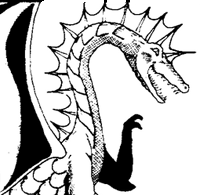In D&D, of course, it was originally decided that the five types of chromatic dragon should be distinguished by each having a unique attack, so that green dragons breathe poison, black dragons acid, and so on. Naturally, the most powerful of all the chromatic dragons was going to be the one that breathed fire, fitting the legends on which the broader idea is based.
Thursday 22 July 2021
D&D Monsters: Red Dragons
Thursday 8 July 2021
D&D Monsters: Green Dragons
In D&D, the basilisk is quite a different creature, and very far from being legless. While the association of poison with serpentine beings make sense, it's not common in depictions of dragons. The D&D idea of certain dragons belching poisonous gas instead of something flammable is likely an original one - something added so that each of the five chromatic dragons had a unique attack mode. And in this case, of course, that's the green dragon, the mid-point in the five-point scale of increasing chromatic dragon power.
Thursday 1 July 2021
D&D Monsters: Black Dragons
Given that they're right there in the name of the game, dragons are obviously fairly key to D&D. In the 1st edition, they receive more detailed options than other monsters, having eight age categories and three size classes, and a suite of special abilities right from the beginning. Furthermore, there are no less than ten different kinds of true dragon, divided evenly between the good 'metallic' and the evil 'chromatic' species.


